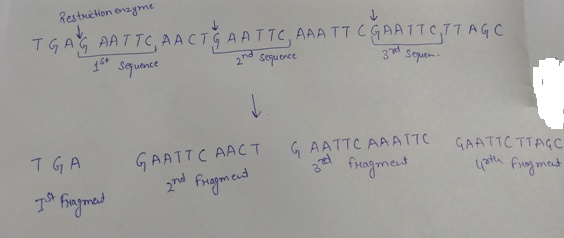
Concept explainers
If a restriction enzyme cuts between the G and the A whenever it encounters the sequence GAATTC, how many fragments will be produced when the enzyme is digested with DNA with the following sequence? TGAGAATTCAACTGAATTCAAATTCGAATTCTTAGC
- a. Two
- b. Three
- c. Four
- d. Five
Introduction:
Restriction enzymes are the enzymes that digest the higher molecular weight DNA in to smaller fragments. They are also known as restriction endonucleases.
Answer to Problem 1MCQ
Correct answer:
There are three sequences of GAATTC present on the DNA fragment and the fragments formed after the cleavage of the DNA are four in numbers. Therefore, option (c) is correct.
Explanation of Solution
Reason for correct statement:
Restriction endonucleases digest a double stranded DNA at specific sites. These specific sites are also called recognition site that present as palindrome. If the restriction enzyme given cuts between the G and A whenever it encounters the sequence GAATTC on the given DNA with the following sequence TGAGAATTCTGAATTCAAATTCGAATTCTTAGC, the cleaving of the DNA will be given as follows:

As shown, after the cleavage of the DNA by the help of the restriction enzyme, four fragments will be formed.
Option (c) is given as “Four”.
As, “the restriction enzyme recognizes three sequence on the given DNA, so it will make three cuts, that results in the production of the four DNA fragments,” is the right answer.
Hence, option (c) is correct.
Reasons for the incorrect statements:
Option (a), is given as “Two”.
The fragments of the DNA formed will be four after the action of the restriction enzyme. Hence, it is a wrong answer.
Option (b), is given as “Three”.
The DNA fragment formed after the cleavage will be four in numbers. Hence, it is a wrong answer.
Option (d), is given as “Five”.
For DNA fragments will be formed after the cutting action of the restriction enzyme at the given recognition site. Hence, it is a wrong answer.
Hence, options (a), (b), and (d), are incorrect.
Restriction enzymes are also known as molecular scissors that could cut double stranded DNA molecules at specific sites. It is an important tool that is used in the manipulation of DNA.
Want to see more full solutions like this?
Chapter 11 Solutions
BIOLOGY: CONCEPTS AND INVESTIGATIONS,
Additional Science Textbook Solutions
Physics for Scientists and Engineers
Introductory Chemistry (6th Edition)
Laboratory Manual For Human Anatomy & Physiology
Microbiology Fundamentals: A Clinical Approach
Human Physiology: An Integrated Approach (8th Edition)
- Identify the phylum or class. a. Euglenophyta b. Dinoflagellata c. Bacillariophyceae d. Oomycetes e. Phaeophyceae O f. Myxomycota g. Xanthophyceae ○ h. Chrysophyceae i. Dictyosteliomycota O j. Rhodophyta Ok. Chlorophyceaens I. Charophyceaensarrow_forwardWhat is produced inside the indicated structure (Fucus). a. eggs O b. antheridia ○ c. sperm d. zygotes e. none of thesearrow_forwardGreen Algae, as a group, is actually paraphyletic with one subgroup more closely related to higher plants than the other. Which of the following green algae groups is more closely related to higher plants: a. Charophyceans b. Chlorophyceans c. Rhodophyta d. Xanthophyceansarrow_forward
- A single-celled green algal genus that is motile with 2 flagella, has a cup shaped chloroplast, and an eyespot: a. Volvox b. Chlamydomonas c. Euglena d. Codiumarrow_forwardA[n] ___ is produced by members of the Myxomycota when there is a lack of moisture. a. plasmodiocarp b. aethalium c. sclerotium d. plasmodiumarrow_forwardWhich of the following is not true about the life-cycle of Fucus. a. 8 eggs per oogonium b. 64 sperm per antheridium c. eggs are flagellated d. sperm are flagellatedarrow_forward
- Green Algae, as a group, is actually paraphyletic with one subgroup more closely related to higher plants than the other. Which of the following green algae groups is more closely related to higher plants: a. Charophyceans b. Chlorophyceans c. Rhodophyta d. Xanthophyceansarrow_forwardCertain toxic terpenoids in this group is thought to deter herbivory but may also have some anti-tumor activity? a. green algae b. brown algae c. red algae d. golden algae e. none of thesearrow_forwardIn the cellular slime molds, the most common phase is: a. plasmodium b. pseudoplasmodial c. single cells as myxamoebae d. moundingarrow_forward
- Which of the following descriptive terms does not describe Hydrodictyon? a. colonial b. nonmotile c. 1 large reticulated chloroplast in each cell d. all of these describe Hydrodictyonarrow_forwardWhich of the following does not apply to Chara? a. "stoneworts" b. isogamous c. calcified walls d. apical growth with an axis and branchesarrow_forwardtell us about one time when you went the extra mile when it would be acceptable to perform the bare minimum. why did you exert the extra effort and what was the outcome?arrow_forward
 Concepts of BiologyBiologyISBN:9781938168116Author:Samantha Fowler, Rebecca Roush, James WisePublisher:OpenStax College
Concepts of BiologyBiologyISBN:9781938168116Author:Samantha Fowler, Rebecca Roush, James WisePublisher:OpenStax College
 Human Heredity: Principles and Issues (MindTap Co...BiologyISBN:9781305251052Author:Michael CummingsPublisher:Cengage Learning
Human Heredity: Principles and Issues (MindTap Co...BiologyISBN:9781305251052Author:Michael CummingsPublisher:Cengage Learning Biology: The Dynamic Science (MindTap Course List)BiologyISBN:9781305389892Author:Peter J. Russell, Paul E. Hertz, Beverly McMillanPublisher:Cengage Learning
Biology: The Dynamic Science (MindTap Course List)BiologyISBN:9781305389892Author:Peter J. Russell, Paul E. Hertz, Beverly McMillanPublisher:Cengage Learning Human Biology (MindTap Course List)BiologyISBN:9781305112100Author:Cecie Starr, Beverly McMillanPublisher:Cengage Learning
Human Biology (MindTap Course List)BiologyISBN:9781305112100Author:Cecie Starr, Beverly McMillanPublisher:Cengage Learning Biology Today and Tomorrow without Physiology (Mi...BiologyISBN:9781305117396Author:Cecie Starr, Christine Evers, Lisa StarrPublisher:Cengage Learning
Biology Today and Tomorrow without Physiology (Mi...BiologyISBN:9781305117396Author:Cecie Starr, Christine Evers, Lisa StarrPublisher:Cengage Learning





